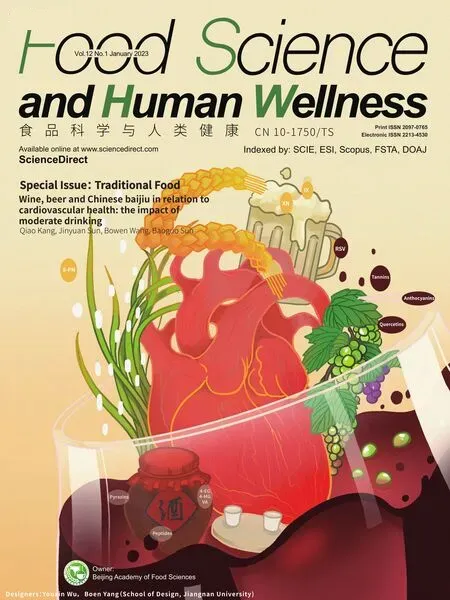Characterization of the key aroma compounds in four varieties of pomegranate juice by gas chromatography-mass spectrometry (GC-MS), gas chromatography-olfactometry (GC-O), odor activity value (OAV),aroma recombination, and omission tests
2023-01-22conglua,yuyuzhang,pingzhana等
Keywords:Pomegranate juice Aroma-active compounds GC-MS GC-O Odor active value (OAV)Omission tests
A B S T R A C T P omegranate (Punica granatum L.) has attracted considerable attention in world markets due to its valuable nutrients and highly appreciated sensory properties. The aroma profiles of 4 varieties of pomegranate juice,including Dahongtian (DP), Jingpitian (JP), Luyudan (LP), and Tianhonngdan (TP), were investigated via gas chromatography-mass spectrometry (GC-MS) and gas chromatography-olfactometry (GC-O) analyses. A total of 43 volatile compounds were identified by using GC-MS. Among these compounds, 16 were considered as potential aroma-active compounds as detected by GC-O. These compounds belonged to the classes of terpinenes, alcohols, and aldehydes. Eleven volatile compounds were defined as the main contributors to the overall aroma of pomegranate juice due to their high odor activity values (OAVs ≥ 1). Aroma recombination and omission tests confirmed that β-myrcene, 1-hexanol, and (Z)-3-hexen-1-ol were the key aroma compounds,and limonene, 1-octen-3-ol, linalool, and hexanal were important aroma-active compounds in DP samples.
1. Introduction
Phytonutrient-rich fruits are in high demand due to their healthpromoting effects. Pomegranate (Punica granatumL.) is exceedingly popular worldwide because of its antiatherogenic, antioxidant, and antihypertensive properties [1-4]. In the past several decades, many pomegranate varieties, such as Dahongtian (DP), Jingpitian (JP),Luyudan (LP), and Tianhonngdan (TP), have been widely planted in pomegranate orchards in northwestern China. Pomegranate is mainly consumed in the form of fresh fruit or processed into products, such as fresh juices, canned beverages, jellies, and jams [5].
Aroma is one of the most important quality attributes that greatly affects the sensory experience of consumers. Recently, increasing numbers of investigations on the aroma of pomegranate have been carried out, and several aroma compounds have successfully been identified. Melgarejo et al. [6] identified 83 different aroma compounds, including terpenes, furans, esters, acids, ketones, alcohols,and aldehydes, in 14 pomegranate juices (1 fresh-squeezed and 13 commercial juices). A previous study found that 7 terpinenes are greatly related to consumer preference [7]. Melgarejo et al. [6] extracted and analyzed 21 volatile compounds from 9 pomegranate cultivars grown in Spain. Statistical analysis indicated that the monoterpenes and aldehydes present in pomegranate have a positive effect on consumer preferences. Besides, Beaulieu and Obando-Ulloa [8]investigated the interaction effects of temperature and storage on the aroma of NFC pomegranate juice. Although approximately 100 volatile compounds have been characterized in pomegranate [6-12],only a limited number of these compounds are known as key aroma compounds that may contribute to the overall aroma profile of pomegranate juice. Gas chromatography-olfactometry (GC-O)analysis and odor activity values (OAVs) have emerged as efficient tools for the identification of key aroma compounds. A total of 19 and 22 compounds were identified as the key aroma compounds in durian fruit and mandarin, respectively [13,14], by using gas chromatography-mass spectrometry (GC-MS), GC-O, and OAV.These componds were individually separated from the original juice system and subsequently analyzed. However, this approach failed to consider the perceptual interactions, such as antagonism, suppression,and synergism, of odorants. These compounds could only represent the aroma of a single compound, not the overall aroma of the juices [15-19].In this case, omission tests are necessary to verify and rank the aroma contributions of volatile compounds by eliminating a single compound or a group of compounds from the aroma model [13,14,20].
Even if extensive investigations on the aroma of pomegranate have been undertaken, systematic studies on the key aroma compounds in pomegranate juice remain lacking. The aims of this study were (i) to select a highly popular variety of pomegranate juice through quantitative descriptive analysis (QDA) and GC-MS analysis; (ii) to identify the key aroma compounds in the highly popular pomegranate variety through GC-O and OAVs; and (iii)to verify key aroma contributors via aroma recombination and omission experiments. This study may reveal the key aroma compounds in pomegranate juice and help improve the flavor of pomegranate juice.
2. Materials and methods
2.1 Materials and chemicals
All authentic standards for aroma model recombination were obtained from Sigma-Aldrich, including ethyl acetate (99%), methyl salicylate (96%),β-pinene (97%), limonene (99%),β-myrcene(97%), 2-carene (97%),β-phellandrene (99%),α-caryophyllene(97%),β-caryophyllene (97%),p-cymene (96%),β-bisabolene(98%), naphthalene (97%),γ-terpinene (99%), styrene (98%),transα-bergamotene (96%),cis-β-farnesene (99%),α-terpineol (99%),terpinen-4-ol (98%), linalool (99%), 1-hexanol (99%),cis-verbenol(97%), (Z)-3-hexen-1-ol (98%), 1-octen-3-ol (99%), 1-heptanol(98%), (E)-2-hexen-1-ol (96%), 2-ethyl-1-hexanol (95%), 2-nonen-1-ol (98%), eucalyptol (97%), 2-butyl-1-octanol (95%), 1-nonanol(99%), carveol (97%), 1-octanol (94%), levomenthol (96%), hexanal(99%), nonanal (98%), decanal (98%), octanal (96%), (Z)-2-heptenal(96%), (E)-2-octenal (98%), (E)-2-decenal (98%), (E,E)-2,4-nonadienal (96%), (E)-2-hexenal (98%), and 6-methyl-5-hepten-2-one(99%). A C7–C40n-alkane mixture (o2si smart solutions, USA) was used to determination of the retention index (RI). Distilled water was purchased from Wahaha Group Company (Hangzhou, China).
2.2 Pomegranate juice preparation
A total of 200 kg of 4 pomegranate varieties (DP, JP, LP, and TP)were harvested (50 kg each) from the pomegranate plantation in Lintong District, Xi’an City, Shaanxi Province, China, in October 2020. All pomegranate fruits were washed by distilled water and squeezed into juice by a household juicer (TJE06A-400; Supor Co., Ltd., Shaoxing, Zhejiang, China). The fruit juices were immediately filtered through four layers of gauze and were kept in a refrigerator (–40 °C) until analyzed.
2.3 Sensory evaluation
QDA was performed by 10 well-trained panelists (all Chinese, 4 males/6 females, 24 years old on average). All evaluations were performed in the laboratory of flavor and nutrition at Shaanxi Normal University illuminated with white light that conformed to the international standards [21].The evaluation was performed in a sensory evaluation room((21 ± 1) °C). Each sample (100 mL) was placed into odorless,disposable plastic cup (150 mL) with a screw cap, and was labeled with three-digit codes in a random. Prior to evaluation, the panelists were trained to describe the odor qualities of 4 varieties of pomegranate juice samples and standard odorants. Finally, in order to evaluate the differences and popularity of the 4 samples,7 descriptors, namely, floral, fruity, sweet, woody, earthy/musty,green, and overall-liking, were obtained. The descriptors were selected on the basis of the sensory lexicon [22] and the standard reference details for descriptor definition were presented in our previous study [23]. Panelists were asked to rate the intensity of each descriptor on a seven-point linear scale ranging from 0 to 3 with 0.5 increments and with 0 = not detectable, 1 = weak, 2 = moderate, 3 =strong [24]. Moreover, the possess data were averaged based on the scores of all trained panelists in triplicate for seven descriptors and plotted in a spider web diagram.
2.4 Extraction of volatile compounds of pomegranate juices by HS-SPME
Pomegranate juice samples were extracted by HS-SPME and the extraction procedures were conducted as follows: a total of 5 g of pomegranate juice, 2 g of sodium chloride, and 1μL of 1,2-dichlorobenzene (0.16 mg/kg) were immediately transferred to a 20 mL headspace (HS) vial. Afterward, the vial was put into a thermostatic water bath for 20 min at 40 °C. The fiber 50/30 μm divinybenzene/carboxen/polydimethylsiloxane (DVB/CAR/PDMS) was exposed to the headspace of the sample (the length of the extraction fiber was about 1 cm, and it was 1 cm above the liquid surface) for 40 min at 40 °C with a stirring speed of 600 r/min. Then, the fiber was directly desorbed in the inlet at 250 °C using a SPME liner of a gas chromatography system equipped with a tandem mass spectrometry detector and an olfactory detection port (GC-MS-O) for 7 min. All samples were performed in triplicate.
2.5 GC-MS and GC-O analysis
2.5.1 GC-MS analysis
A gas chromatograph (GC) 7980B coupled with a 5977 mass selective detector (MS) (Agilent Technologies) was used. In detail,a polar DB-WAX and a non-polar DB-5 chromatographic capillary column (30 m length × 0.25 mm i.d. × 0.25 µm film thickness,Agilent Technologies, USA) were used to separate and identify the volatile compounds. Helium (purity > 99.999%) was used as the carrier gas and delivered at a constant rate of 0.9 mL/min to the column. Different GC oven temperature conditions were optimized for each column. For the DB-WAX column, GC oven program started at 40 °C for 5 min, then the gradient heating-up method was carried out at a heating rate of 5 °C/min, successively increased to 120 °C,220 °C, and kept each temperature for 10 min, 5 min, respectively.For the HP-5 column, the oven temperature was initially kept at 40 °C for 3 min, ramped to 140 °C at a rate of 2 °C/min with a 5 min hold,then raised to 180 °C at 8 °C/min and finally to 230 °C at 20 °C/min with a 1 min final hold.
Mass spectra conditions: electron impact (EI) ionization voltage of 70 eV, filament current of 80 µA, and electron multiplier voltage of 1 000 V, iron source temperature of 200 °C, and mass range ofm/z35-550 with 4.37 scan/s and no solvent delay. The volatile compounds were then identified and quantified.
2.5.2 GC-O analysis
A GC 7980B equipped with a sniffing port (Sniffer 9100 System,Brechbuhler, Switzerland) was used to perform the GC-O analysis.DB-WAX was used as the analytical column, and the other GC parameters were identical to those of GC-MS analysis. The volatile compounds extracted were separated between the olfactory detection port and the MS with a same ratio (1:1). The temperature of the transfer line and the temperature of the GC-O injector were 250 and 230 °C, respectively. In order to keep the nasal mucosa moist,the temperature of sniffing port was hold at 25 °C, provided by humidified air. A long enough time was used to capture all the aroma active compounds, and entire sniffing experiment lasted 56 min. The conditions of ramping procedure was consistent with the Section of GC-MS analysis.
Before the GC-O analysis experiment, 10 panelists were trained for the odor characteristics about 43 reference standards for up to 30 h in their concentrations 10 times above their odor thresholds.During a GC run, a panelist placed his or her nose close to the top of the sniffing port, recorded the aroma intensity value of the stimulus,aroma descriptor as well as retention time. The panelists recorded the aroma intensity value according to a six-point scale from 0 to 5: “0”indicated that odor was none, “3” was moderate, and “5” was very strong [14]. The experiments were carried out in triplicate for each sample by every panelist.
2.6 Identification and quantification of volatile compounds
Volatile compounds were identified using three different analytical methods: (i) mass spectra (authentic chemicals and NIST14L spectral library collection); (ii) Retention indices (RI).Identification was considered tentative when it was only based on mass spectral data.n-Alkanes mixture (C7–C40) (o2si smart solutions, USA) was used for the calculation of RI; (iii) Standards(St). Identification was confirmed by comparing the corresponding high purity GC-MS grade standards, which were obtained from: F =Fluka (Madison, WI), S = Sigma (Sigma-Aldrich) Inc. To evaluated the quantification of the volatile compounds, authentic standard calibration curves were conducted using 1,2-dichlorobenzene and high purity GC-MS commercially standards of volatile compounds mixed in a model containing the natural TSS and pH measured in the pomegranate sample. In the calibration curves,xandyrepresent the concentration ratio (concentration of the standard of volatile compounds/internal standard) and the peak area ratio (peak area of standard/ internal standard), respectively. The mean values were calculated by the triplicate analysis [25]. In order to ensure the accuracy of the results, the recovery yield (R) of the internal standard was performed, which was the ratio of peak area of internal standard added into the sample (Padded) to the peak area of the single internal standard (Preal), namelyR= Padded/Preal. And the recovery yield of 1,2-dichlorobenzene (internal standard) was 95.31%.
2.7 OAVs calculation
OAVs are used to evaluate the contributions of aroma compounds.OAV was calculated by dividing the calculated concentrations (C)with the odor threshold (OT) in water. Numerically, compounds with an OAV ≥ 1 are generally considered to greatly contribute to the aroma characteristics.
2.8 Aroma recombination
To sufficiently and exactly obtain a model that was similar to original pomegranate juice, commercial standards of aroma-active compounds (OAV ≥ 1) were mixed in Milli-Q deionized water under their original concentration [26]. Considering that the influence of non-volatile compounds on the overall aroma of pomegranate juice,we determined the main soluble sugars and organic acids. The 100 g model juice contained sucrose, 2.2 g; glucose, 1.8 g; fructose, 5.2 g;citric acid, 3.25 g; malic acid, 0.07 g; tartaric acid 0.14 g; ascorbic acid 2.8 g; Milli-Q deionized water, 84.54 g. The six aroma descriptors of the pomegranate juice sample and the recombination model were evaluated by 10 panelists.
2.9 Omission tests
A total of 13 aroma omission models were prepared to investigate the contribution of one or one group aroma-active compound in pomegranate juice. Triangle tests, as described in previous studies [27]were used to evaluate the difference between each model and the recombinational model. Each test sample were arranged in a random order, and the panelists perceived the samples and determined the different one from one omission model and two complete recombination samples.
2.10 Statistical analysis
All experimental results were conducted in triplicates. Significant differences were determined by one-way analysis of variance(ANOVA) using SPSS version 23.0 (IBM, Chicago, IL, USA). Spider web diagrams and total ion chromatograms were conducted using Origin Pro software (version 9.1, Origin Lab Inc., USA). In addition,heatmap and stacked bar graph for aroma-active compounds based on TBtools software (https://github.com/CJ-Chen/TBtools).
3. Results and discussion
3.1 Sensory profiles of pomegranate juice
QDA was used to evaluate the overall aroma characteristics of pomegranate juice from 4 different varieties. Seven descriptors,namely, floral, fruity, sweet, woody, earthy/musty, green, and overall-liking were obtained by the trained panelists. As shown in Fig. 1, 4 samples had similar aroma characteristics, but differed in aroma intensity. Variety, maturity and storage could be the main factors affecting fruit aroma [28,29]. Floral, fruity, and woody notes scored higher aroma intensity than the other 3 aroma notes,indicating their potential to be the dominated aroma notes in pomegranate juice. Among 4 varieties, DP was characterized by floral note, with a score of 2.5, followed by, sweet (1.5), woody(1.5), and fruity (1.5), whereas a lower intensity of the earthy/musty note. In general, the DP sample showed the highest overallliking than other varieties.

Fig. 1 Sensory profile of pomegranate juice via QDA (panel number = 10).
3.2 Qualitative and quantitative analysis of volatile compounds in the four pomegranate juice samples
The volatile compounds in each pomegranate juice sample were extracted by the HS-SPME and analyzed by the GC-MS.Then the volatile compounds were tentatively determined using the statistical comparison function in Mass-Hunter software (MS). The experimental RI calculated by n-alkane series ranged were compared with the reported retention values (the reported retention values were cited from the web of http://webbook./nist.gov/chemistry). In order to further verify the analysis results of volatile compounds, some high purity GC-MS commercial standards (St) were used under the same analysis conditions. As shown in Table 1, DB-WAX and DB-5 had identified 43 and 23 volatile compounds, respectively. However,according to the optimized experiments, the DB-WAX column was more suitable for the identification of volatile compounds in pomegranate juice, in comparison with DB-5.
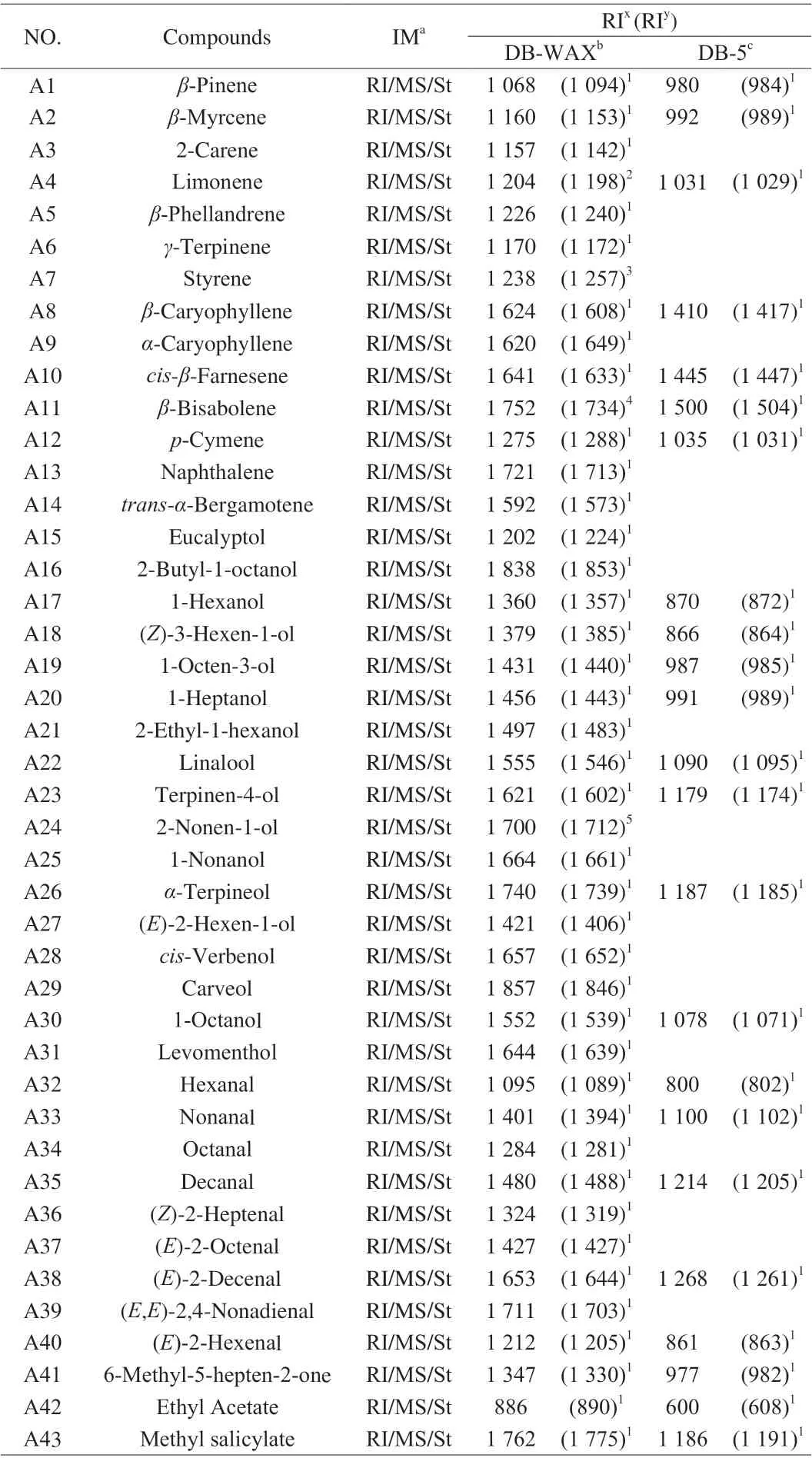
Table 1 Volatile compounds identified by polar and non-polar columns in pomegranate juice.
As shown in Table 2, volatile compounds were classified into 5 different chemical classes, in which alcohols (17) and terpenes (14)were the predominant volatile compounds in pomegranate juice,followed by aldehydes (9), esters (2), and ketone (1). Among those compounds, C6alcohols (1-hexanol and (Z)-3-hexen-1-ol) and C6aldehydes (hexanal) were reported as indispensable contributors to the aroma of green and grass note in pomegranate juice [30].On a quantitative level, 1-hexanol was the most abundant volatile compound in the range of 71.126–210.91 μg/kg, with the highest value of 210.91 μg/kg in DP. Interestingly, 1-hexanol was accurately identified as an aroma-active compound, which has been consistently detected in pomegranate juice in previous studies [7,10,12,31].Other quantity-predominant compounds,β-caryophyllene, sweet and woody note, has been identified frequently in pomegranate juice, and was once perceived as the aroma-active compound by GC-O [32].A comparison of the four pomegranate juice samples (Table 2)showed that the concentration ofα-caryophyllene, styrene,cis-βfarnesene, andγ-terpinene in DP was much higher than other samples,which may contribute to woody note for pomegranate juice. Alcohols were also present a higher concentrations in JP. Among the alcohols,heptanol, and terpinen-4-ol were described as erathy/musty note,which were consistent with the sensory results. Three compounds,including, 6-methyl-5-hepten-2-one, (E,E)-2,4-nonadienal, and ethyl acetate, were only detected in LP, however, they couldn’t promoted the overall aroma profile due to the higher thresholds. The quality and quantity of volatile compounds in TP were lower, possibly due to the variety of TP, which showed weak overall aroma profile. The other 5 compounds (methyl benzoate, ethyl benzoate, 1-hexanol, (Z)-3-hexenol, (E)-2-decenal) were considered as the potent contributors in the aroma profile. On the contrary, other compounds presented at low mean concentrations, includingβ-myrcene (10.641 μg/kg), 1-octen-3-ol (3.443 μg/kg), 1-heptanol (3.106 μg/kg), linalool (6.357 μg/kg),and naphthalene (1.958 μg/kg).
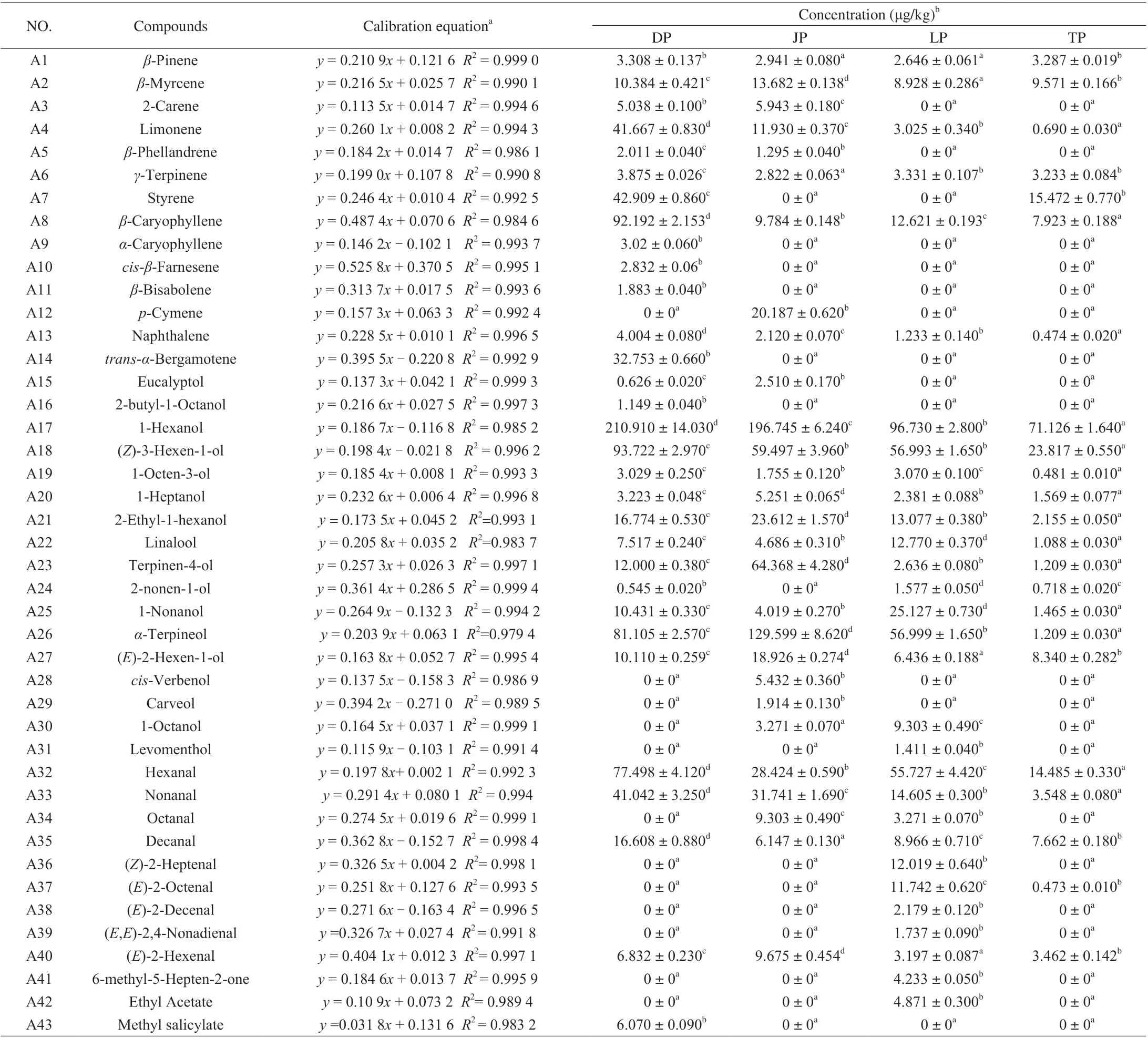
Table 2 Average concentration of volatile compounds detected in pomegranate samples.
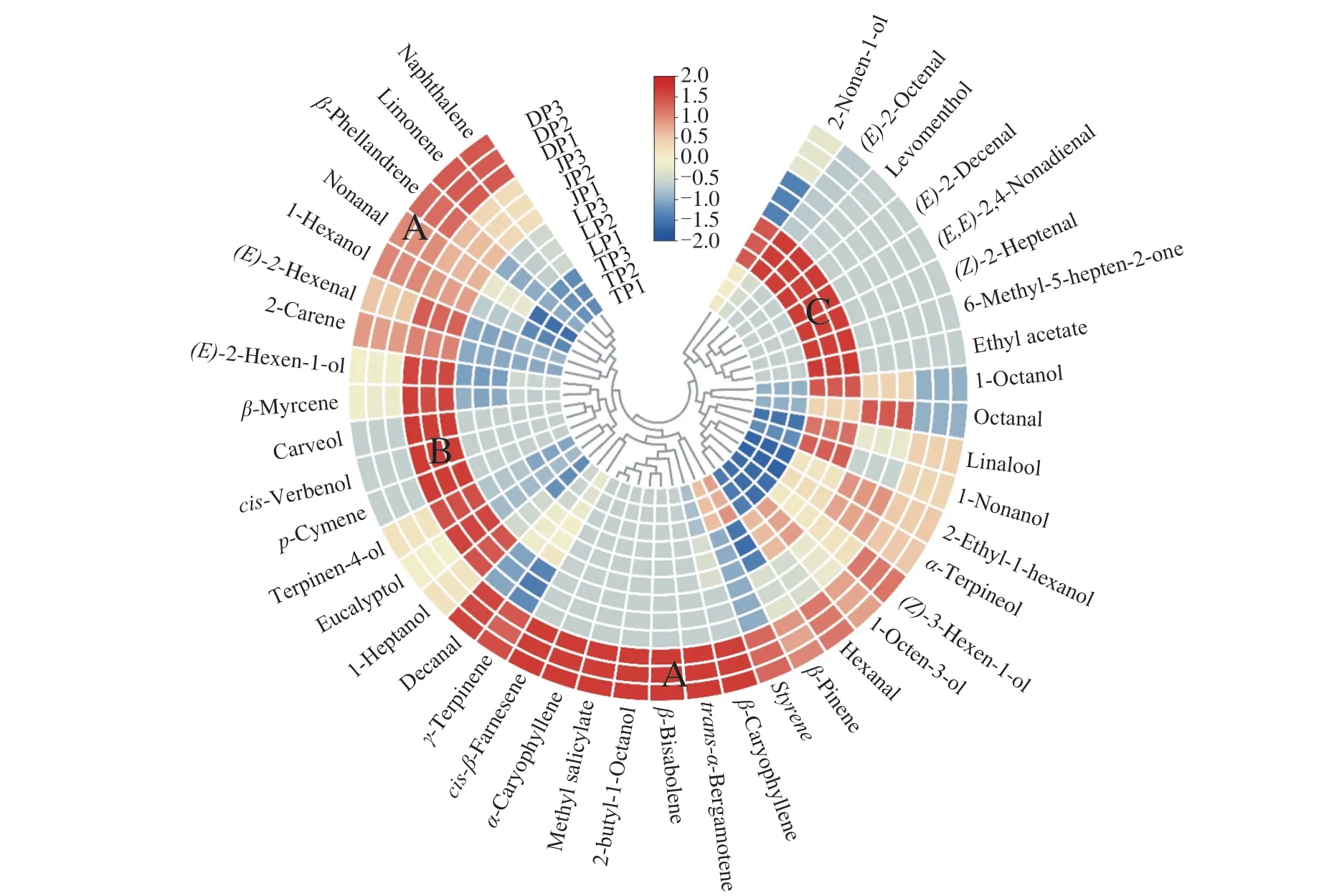
Fig. 2 Heat map and HCA clustering results of 43 volatile compounds with a significant difference in four cultivars pomegranate juice ( P < 0.05).
Hierarchical cluster analysis (HCA) was used to demonstrate inter-correlations between 43 aroma compounds and how they could be clustered for distinguishing pomegranate juice samples,as shown in Fig. 2. In the areas A, B, and C, volatile compounds with significantly higher (P< 0.05) concentrations than in the other samples and the concentration of volatile compounds were clearly distinguished with different colors. These results raised our interests to answer the question: Does the higher concentration compound quantified by the real standard calibration curve have a positive contribution to the overall aroma quality of pomegranate juice, while the lower concentration compound does not? For this question, GC-O and OAVs analysis were carried because they could provide more authentic effects in the overall aroma quality of samples.
3.3 Aroma-active compounds identified by GC-O analysis in pomegranate juice
GC-O is a method equipping a human olfactometer, which has been used to analyze samples , and this method is very useful in identifying and ranking the contribution of aroma-active compounds in complex and mixed system [32,33]. As shown in Table 3, sixteen aroma-active compounds were detected including terpenes (5),alcohols (7), aldehydes (3), and ketone (1). Fig. 3 showed the differences between the concentration of aroma-active compounds and intensity in four samples, heat map of concentrations (Fig. 3A) and stacked bar graph of aroma intensity (Fig. 3B). The differences were indicate vis the size and color of symbols clearly. Kulkarni [34,35]revealed that terpenes play an important role in governing PG flavor and overall customer preference. Among these terpenes, limonene(AI, 1−2.9) was the most powerful aroma-active compound which was perceived in all the samples. Limonene has a lemon, citrus aroma and was the key aroma-active compound in pomegranate [12], in line with our research. Woody aroma also played an indispensable role in the aroma quality of pomegranate,β-pinene (AI, 1.5–2.0)andβ-caryophyllene (AI, 0.5–1.8) seemed to be the most important compounds for woody note due to their moderate intensity of aroma.
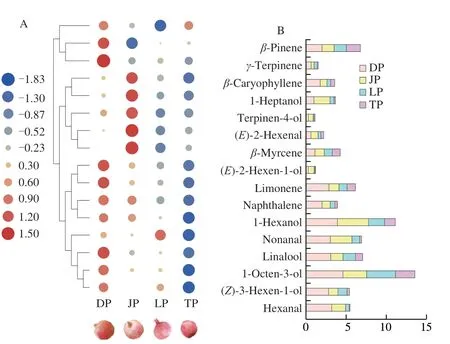
Fig. 3 Heat map of concentrations of the aroma active compounds in pomegranate juices from four cultivars by GC-O (A); Stacked bar graph of aroma intensity of aroma active compounds (B)
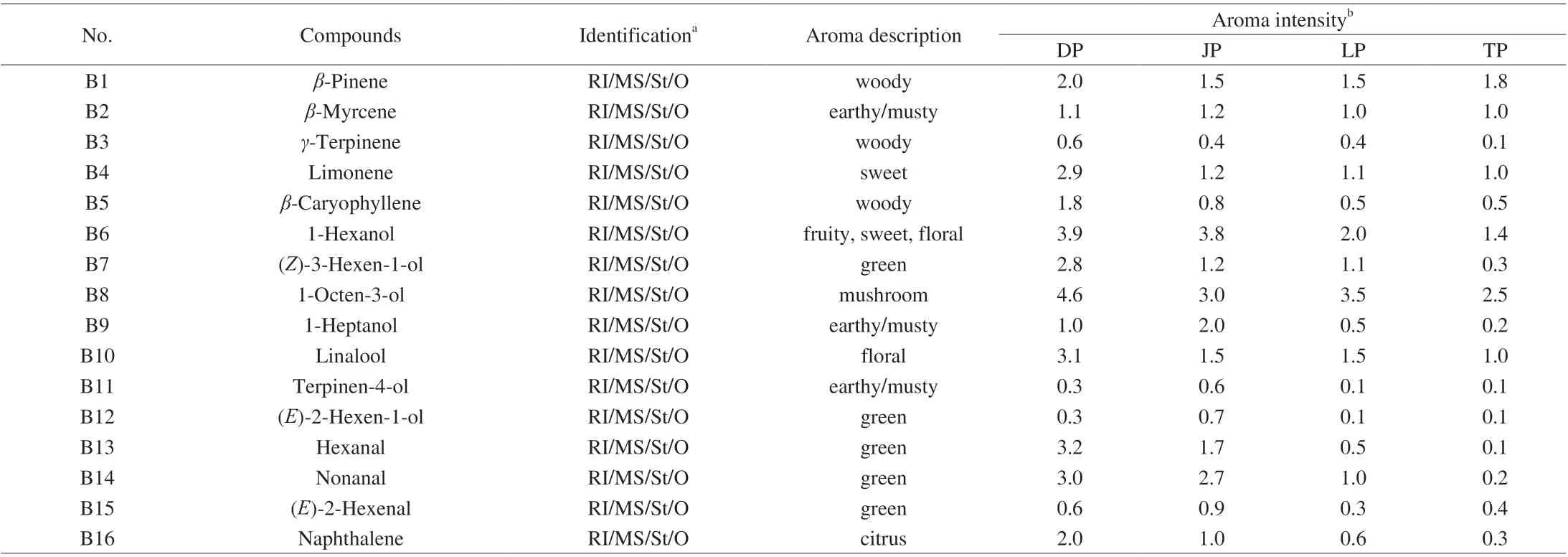
Table 3 GC-O identified aroma-active compounds in four varieties pomegranate juice samples.
Alcohols played an indispensable role in the overall aroma quality of various juice. 1-Octen-3-ol has been reported formed from linoleic acid and 1-penten-3-one [36]. It was described as mushroom-like odor with the highest aroma intensity (AI, 2.5–4.6) in all samples.Two C6 alcohols, namely 1-hexanol, and (Z)-3-hexen-1-ol, original from linoleic acid or linolenic acid by the lipoxygenase pathway [37]and played a key role in the “green” note of pomegranate juice.Especially, 1-hexanol (AI, 1.4–3.9) owned the relatively high concentration and aroma intensity. (Z)-3-hexen-1-ol (0.3–2.8) is catalyzed by (E)-3-hexenal via alcohol dehydrogenase (ADH) [38],and it has been identified as one of the most predominant volatile compounds contributing to the overall aroma for pomegranate juice and other berries [8,39,40]. Floral aroma is an indispensable part of overall aroma of pomegranate, and linalool seemed to the pivotal contributor for the floral descriptor. Interestingly, linalool (1.0–3.1), a terpene alcohol found in various fruits, vegetables, and beverages [9,41,42],presented low concentration with an average content 3.162 μg/kg;however, due to its lower odor threshold (2.4 μg/kg), it still presented a higher aroma intensity. Notably, two C6aldehydes (hexanal, and(E)-2-hexanal) showed a similar green-note, and those compounds might be judged as the key source of green aroma of pomegranate juice. Hexanal (AI, 0.1–3.2) has been widely verified as the key volatile for the overall aroma in various juices [14,39] and was particularly reported as a key aroma-active compound of pomegranate [12].(E)-2-Hexanal (AI = 0.3–0.9) always exists as a trace or small amount in pomegranate juice, and it is in charge of a similar aroma as freshly cut grass and raw fruits. Nevertheless, due to the low concentration and higher odor thresholds of (E)-2-hexanal in the samples, its contribution to green note was quite faint.
3.4 Aroma-active compounds identified by OAVs analysis in pomegranate juice
The contribution of aroma compounds in pomegranate juice was also determined by their OAVs. According to the previous study [43], the volatile compounds with OAVs ≥ 1 could be regarded as the contributors to the overall aroma of sample. As indicated in Table 4, 11 of the 16 compounds, identified by GC-O,exceeded their respective odor threshold value. Noteworthily,1-octen-3-ol had highest OAV (95.2-1 706), with the mean 688.65 ≥100, indicating that this compound has an indispensable contribution,consistent with the results of GC-O analysis. 1-hexanol (green, OAV 25.36), hexanal (green, OAV 10.14), and nonanal (green, OAV 22.52) had OAV >10 and they could be also regarded as the key aroma compounds in pomegranate juice.β-myrcene (musty, OAV 8.6), (Z)-3-hexen-1-ol (grass OAV 4.51), linalool (flora, OAV 4.06),β-caryophyllene (woody, OAV 1.44), and 1-heptanol (musty, OAV 1.34) were contributors for overall aroma. Among them, 1-octen-3-ol,1-hexanol, (Z)-3-hexen-1-ol, hexanal, nonanal, andβ-myrcene were confirmed to have an important influence on the overall aroma of‘Wonderful’ pomegranate [12]. Other volatile compounds (OAVs < 1),includingβ-pinene,γ-terpinene, (E)-2-hexen-1-ol, and (E)-2-hexenal were considered to make minor synergistic effects.
Although these 4 kinds of pomegranate are the most frequently cultivated varieties in Shaanxi to meet the demand for pomegranate juice in the Northwest. Compared with the number of volatile compounds, sensory evaluation, aroma intensity and OAVs, DP was more popular and more suitable for processing into products.The identification of key aroma compounds in DP helps to improve understanding of the transformation mechanism of key aroma substances in the sterilization process.
3.5 Aroma recombination and omission experiments
We applied aroma recombination and omission experiments to confirm the indispensable role of identified 11 aroma-active compounds with high OAV in the overall aroma profile of DPA completely recombined aroma model was used, consisting of 11 aroma-active compounds in their natural concentrations, using 84.54% distilled-water and 15.46% nonvolatile compounds solution as the matrix.
The sensory evaluation between original DP and recombined DP was undertaken by trained panelists. As shown in Fig. 4, there is nosignificant difference in sensory descriptors between recombination DP and original DP, indicating that 11 aroma-active compounds could characterize the overall aroma profiles of DP. The recombination DP was more inclined to sweet and fruity descriptors whereas the floral,woody, and green descriptors were slightly lower than in the original DP sample. Besides, the earthy/musty descriptor of the recombination DP was similar to those of the original DP. These phenomena may be affected by several olfactory interactions when compounds interact together or interact with the non-volatile compounds.
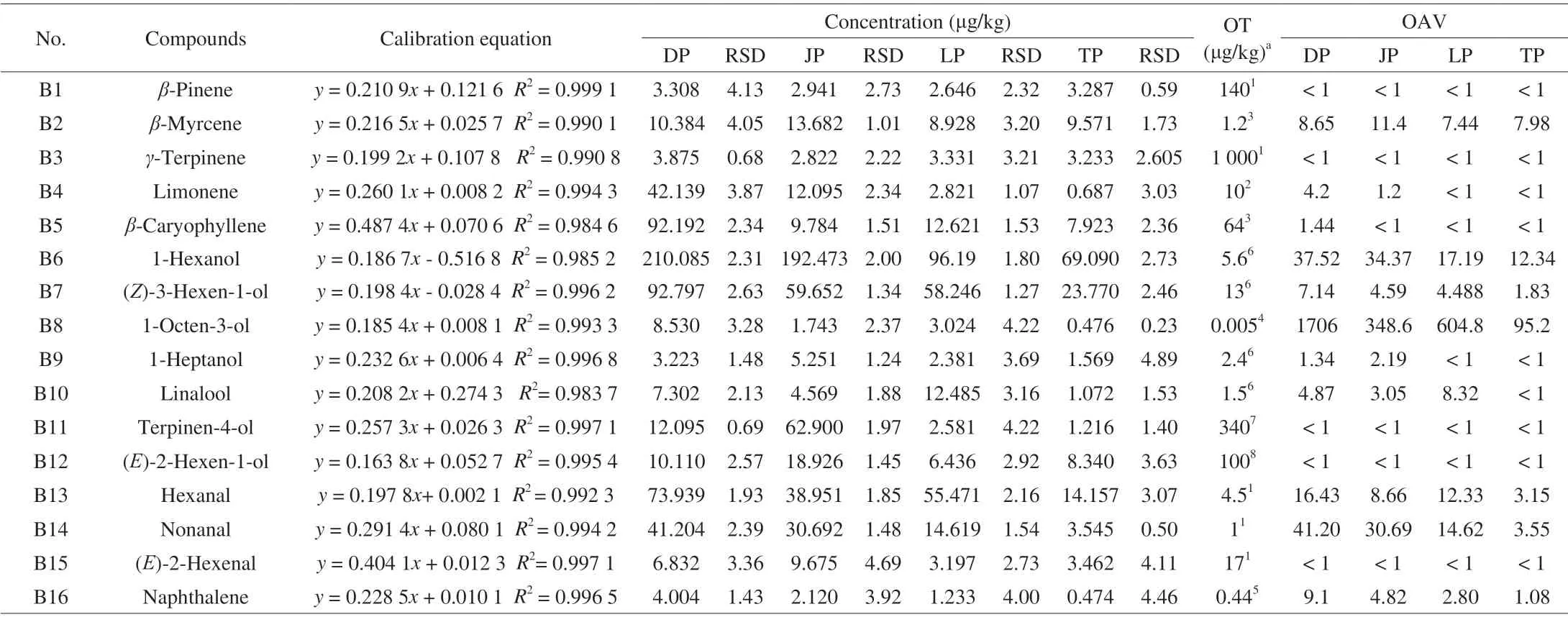
Table 4 Comparison of OAV values of aroma-active compounds in four pomegranate juices.

Fig. 4 Aroma profile of the DP aroma model (11 compounds, OAV ≥ 1) in comparison with the aroma profile of original DP.
The omission experiments were subsequently used to clarify the contribution of the potential key aroma compounds in DP. A
total of 13 aroma-omission models of DP were used to further
investigate the contribution of individual compound or a group of compounds that could characterize the overall aroma profile. These aroma-omission models were evaluated and compared with the completely recombination DP model by sensory panelists through triangle tests. Seven key aroma-active compounds were identified from 16 potent compounds (OAVs ≥ 1), showing a significant difference (P< 0.05) in the omissions models (Table 5). In particular,the models, lacking all terpenes,β-myrcene, all alcohols, (Z)-3-hexen-1-ol, linalool, and 1-hexanol, showed noticeable difference(P< 0.001 orP< 0.01). These findings suggest that these compounds are of great importance for the overall aroma of DP. It is worth noting that although 1-octen-3-ol and nonanal showed high OAVs in DP, excluding 1-octen-3-ol or nonanal from models only resuted in minor changes in the overall aroma profile. This might be due to enhanced or inhibited interactions between key aromatic active compounds. In addition, omitting limonene, linalool, and hexanal caused significant changes (P< 0.05) in recombination DP model, pinpointing the crucial role of these compounds for the overall aroma profile, in accordance with their higher OAVs determined. However, the model lacking inβ-caryophyllene (woody smelling) did not influence the overall aroma profile, andβ-caryophyllene might not be regarded as a crucial contributor for DP. The similar results also occurred with nonanal (green smelling) and naphthalene (citrus smelling), as shown in models 12 and 13.
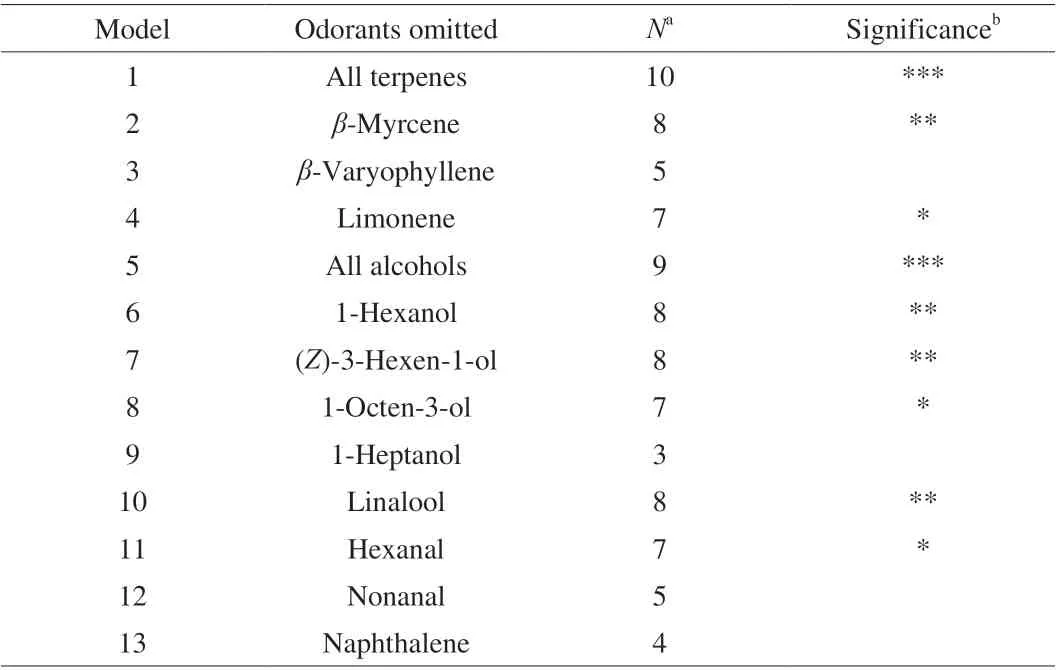
Table 5 Omission test from complete recombination model.
4. Conclusions
In this study, a total of 43 volatile compounds were accurately identified and quantified, in which 16 aroma compounds were marked as potential aroma-active compounds, and 11 volatile compounds were suggested as important aroma-active compounds with high OAVs. The aroma profile of pomegranate juice (DP) could be successfully recombined by 11 aroma-active compounds mixed with their original concentrations. The omission experiments confirmed thatβ-myrcene, 1-hexanol, and (Z)-3-hexen-1-ol were the key aroma compounds for the overall aroma of DP sample. Besides, limonene,1-octen-3-ol, linalool, and hexanal were also important aromaactive compounds. Our findings provide a reliable reference for the subsequent determination of the changing trend of the overall flavor of pomegranate juice by tracing changes in key aroma compounds.Future studies focusing on the transformation mechanism of key aroma compounds after processing are warranted.
Conflicts of interest
The authors have declared no conflict of interest.
Acknowledgements
This research was funded by Shaanxi Natural Science Foundation(2019JQ-665), Xi’an Agricultural Science and Technology Project(20NYYF0021), and supported by the Open Project Program of Beijing Key Laboratory of Flavor Chemistry, Beijing Technology and Business University (BTBU), Beijing 100048, China(SPFW2020YB12).
杂志排行
食品科学与人类健康(英文)的其它文章
- Evaluation and selection of yeasts as potential aroma enhancers for the production of dry-cured ham
- Preserved egg white alleviates DSS-induced colitis in mice through the reduction of oxidative stress, modulation of inf lammatory cytokines,NF-κB, MAPK and gut microbiota composition
- Energy status regulated umami compound metabolism in harvested shiitake mushrooms (Lentinus edodes) with spores triggered to release
- Edible mushrooms as a potent therapeutics of subclinical thyroid dysfunction among adults, especially in obese individuals: a prospective cohort study
- Screening hepatoprotective effective components of Lonicerae japonica Flos based on the spectrum-effect relationship and its mechanism exploring
- Effects of the degree of oral processing on the properties of saliva-participating emulsions: using stewed pork with brown sauce as the model
